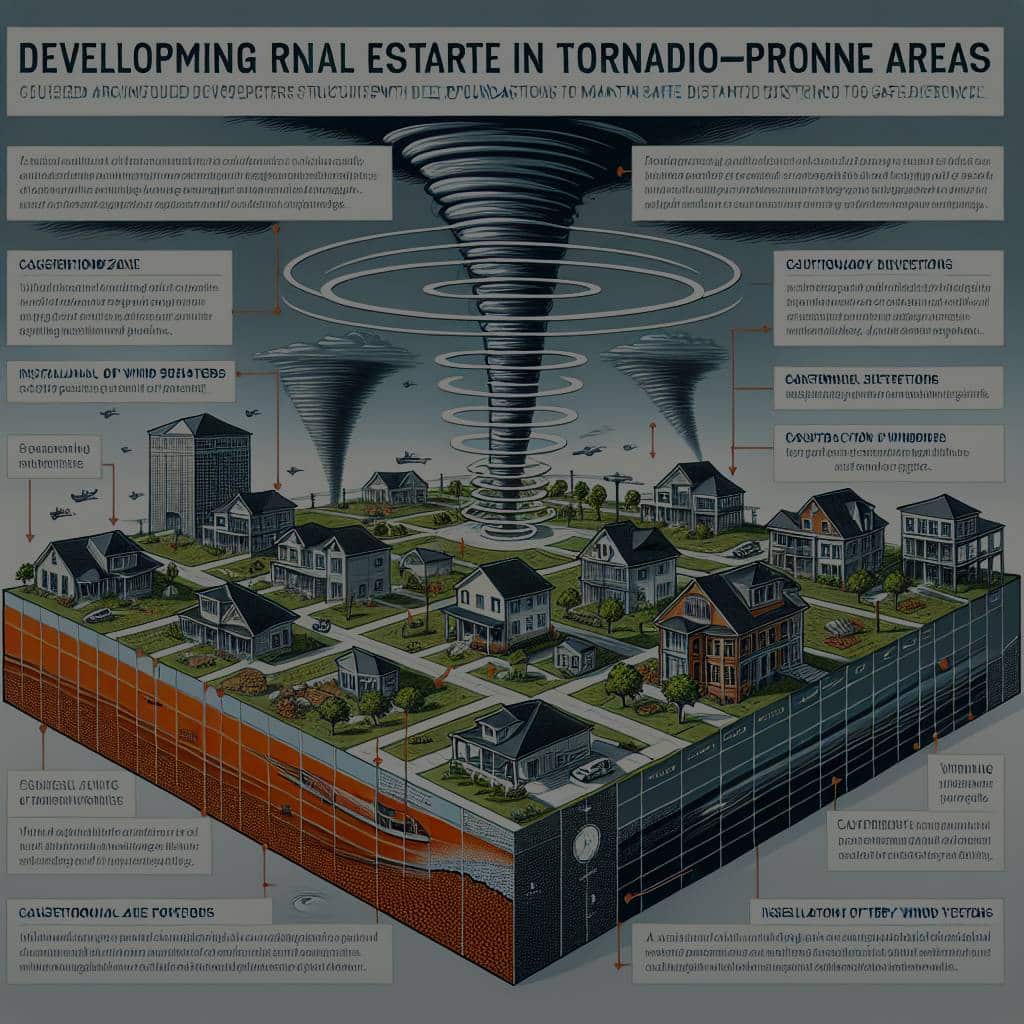What Are the Considerations for Developing Real Estate in Tornado-Prone Areas?

Tornadoes are powerful forces of nature that can cause extensive damage to buildings, homes, and other properties. As a real estate developer, investor, or homeowner, you must take into account the potential threat of tornadoes when developing or purchasing property in tornado-prone areas. This article will delve into some of the key considerations you need to take into account, including building design, insurance, protection systems, and more.
Building Design Considerations for Tornado-Prone Areas
In areas that are prone to high winds and tornadoes, the design of a building is of utmost importance. It’s not just about aesthetics or functionality – it’s about survival. The right design can help to minimize damage caused by these storms and protect the people within.
Lire également : How Can Real Estate Investments Be Leveraged for Tax Benefits in International Markets?
Key design considerations for buildings in tornado-prone areas include the use of reinforced concrete or steel frames, which offer more resistance to high winds than traditional wood frames. The shape of the building also plays a role, with round or hexagonal designs faring better against wind force than square or rectangular ones.
Windows are another critical design element. Consider using impact-resistant glass, which can withstand high wind speeds without shattering. Also, the placement of windows can affect a building’s resistance to wind damage. Windows that face the direction from which tornadoes typically come are more likely to sustain damage than those on other sides of the building.
A voir aussi : What Strategies Can Help Maximize Land Value in Real Estate Development?
Moreover, special attention should be paid to the roof design. A low-sloped or flat roof can reduce the wind’s ability to lift the roof off a building. The use of hurricane straps can also help secure the roof to the main structure of the building, reducing the likelihood of it being torn off during a storm.
Insurance Considerations for Properties in Tornado-Prone Areas
Insurance is a crucial consideration when developing or buying property in areas prone to tornadoes. The right insurance policy can protect you financially in the event of a tornado causing damage to your property.
Many standard homeowner’s insurance policies cover tornado damage. However, it’s important to read your policy carefully to understand what is covered and what isn’t. In some cases, you may need to purchase additional coverage for things like debris removal or living expenses if your home is rendered uninhabitable by a storm.
For commercial property owners and real estate developers, it may be necessary to invest in a comprehensive commercial property insurance policy that covers tornado damage. Again, it’s crucial to understand exactly what your policy covers.
Protection Systems for Buildings in Tornado-Prone Areas
Protection systems for buildings in tornado-prone areas are another key consideration. These can range from physical barriers to advanced technology designed to detect and respond to tornadoes.
One of the most common protection systems is a tornado shelter or safe room. This is a reinforced area of the building designed to protect people during a tornado. It’s typically built to withstand high wind speeds and impact from flying debris.
Beyond physical protection systems, there are also technological solutions. Weather monitoring systems can provide early warnings of incoming storms, allowing people to take cover before a tornado hits. There are also building automation systems that can automatically close windows, shut down HVAC systems, and take other protective measures when a tornado is detected.
Considerations for Buying and Selling Real Estate in Tornado-Prone Areas
When buying or selling real estate in a tornado-prone area, there are unique considerations to keep in mind.
As a buyer, you’ll want to thoroughly assess the property’s vulnerability to tornado damage. This includes looking at the building’s design and construction, checking for the presence of a tornado shelter or safe room, and understanding what insurance coverage is in place.
As a seller, it’s essential to be transparent about the risks of tornado damage. This includes providing potential buyers with information about previous storm damage and steps taken to mitigate future damage.
In conclusion, while developing or buying real estate in tornado-prone areas presents unique challenges, careful planning and consideration can help to mitigate risks and protect your investment. Whether it’s through smart building design, comprehensive insurance coverage, or advanced protection systems, there are many ways to prepare for the threat of tornadoes. By understanding these considerations, you can make informed decisions that balance risk and reward.
The Impact of Tornadoes on Property Values and the Housing Market
Property values and the housing market can fluctuate significantly in tornado-prone areas. It is paramount to keep informed about the local real estate market trends and the impact of natural disasters on property values.
Tornadoes can cause extensive property damage, which can decrease the value of the property. On the other hand, well-designed, tornado-resistant properties may have higher values due to their increased safety features.
It is crucial to take into account the potential for fluctuations in the housing market as well. After a severe weather event such as a tornado, there may be an initial dip in property values. However, these can rebound over time as communities rebuild – sometimes even stronger than before.
Buyers may be cautious about purchasing property in tornado-prone areas, which can impact demand. However, those willing to invest in proper precautions and protections may find these areas offer unique opportunities.
Taking these factors into account, it becomes clear that developing real estate in tornado-prone areas requires a careful analysis of the local housing market and property values. Always consult with experienced real estate professionals in these areas to understand the possible risks and rewards.
Best Practices and Building Codes in Tornado-Prone Areas
Adherence to best practices and building codes in tornado-prone areas is crucial in developing safe and resilient properties. Building codes are sets of rules and standards set by local, state, or national authorities that dictate safe building practices.
In tornado-prone areas, these codes often require specific design features intended to protect against high-speed winds and flying debris. Examples include earth-sheltered designs, impact-resistant windows, reinforced concrete or steel structures, and secure roofing systems.
Following these best practices and building codes not only helps prevent extensive damage caused by tornadoes but also can increase a property’s value and appeal to safety-conscious buyers.
In addition, insurance companies often provide lower rates for properties that adhere to these codes, resulting in long-term financial savings. Therefore, understanding and following the best practices and building codes in tornado-prone areas is a vital aspect of real estate development.
Conclusion
Real estate development in tornado-prone areas is an endeavor steeped in careful consideration and preparation. Through strategic building design, comprehensive insurance coverage, adherence to best practices, and understanding the impact on the housing market and property values, it is possible to mitigate the risks associated with these natural disasters.
By employing advanced protection systems and understanding the local building codes, developers can create structures that can withstand high-speed winds and flying debris, making them more appealing to potential buyers.
Being transparent about the risks and steps taken to mitigate them can also instill confidence in buyers and investors. While the threats cannot be eliminated, they can be managed and prepared for, allowing for a balance between risk and reward in the real estate market in tornado-prone areas.
This careful approach does not only protect a significant investment but also, more importantly, saves lives. Therefore, understanding and applying these considerations should be non-negotiable for any serious real estate developer or investor in tornado-prone areas.
